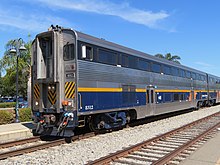| Part of a series on |
| Rail transport |
|---|
 |
|
|
| Infrastructure |
|
|
| Service and rolling stock |
|
| Special systems |
|
|
| Miscellanea |
|
|

Type H Tightlock couplers are a variety of Janney coupler, typically used on North American mainline passenger rail cars. They have mechanical features that reduce slack in normal operation and prevent telescoping in derailments, yet remain compatible with other Janney types used by North American freight railroads.
Like all Janney couplers, the Tightlock is "semi-automatic". The couplers automatically lock when cars are pushed together, but workers must go between cars to hook up the air lines for the pneumatic brakes and connect cables for head-end power and other communications. To separate cars, a worker must use a lever to move the locking pin that keeps the coupler closed.
In Europe, some operators experimented with making fully automatic tightlock couplers by adding integral pneumatic and electric connectors, but these connections proved unreliable, and most have switched to the more common fully automatic Scharfenberg coupler.
Janney Type H Tightlock coupler standards were established by the Association of American Railroads, which transferred the standard to the American Public Transportation Association in 1971 when passenger service was nationalized in the United States from most private railway companies to Amtrak.
On a standard-gauge railway, the nominal mounting height for the coupler (rail top to coupler center) is 33 inches (838 mm), with a 34+1⁄2 ± 1 inch (876 ± 25 mm) maximum height on empty cars and 31+1⁄2 ± 1 inch (800 ± 25 mm) minimum height on loaded cars.[1]
- ^ AAR Manual of Standards and Recommended Practices, Section S, Part I:Casting Details, Issue 06/2007